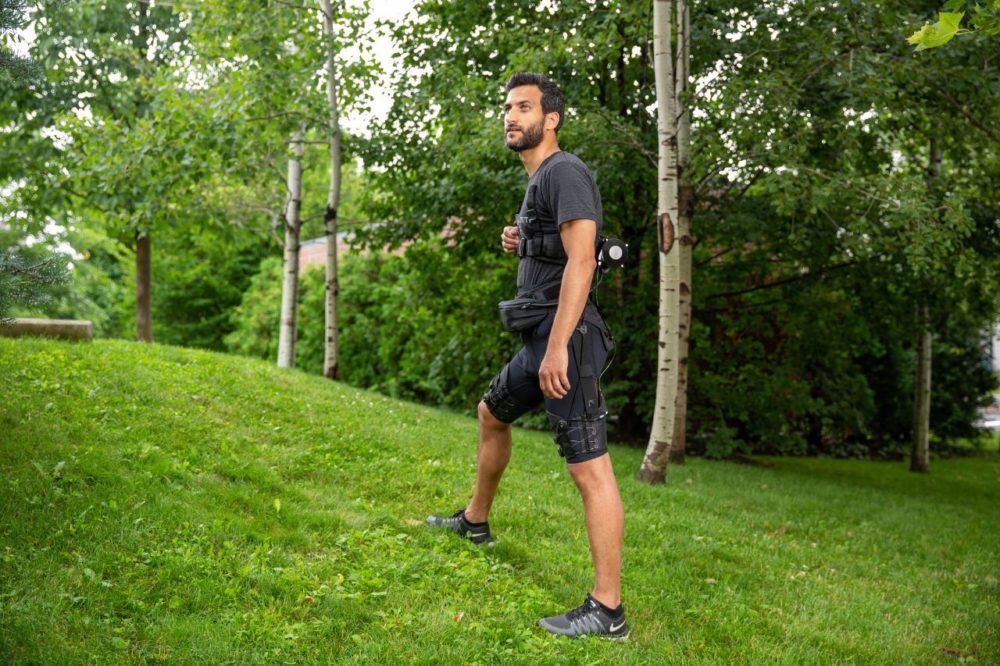Advertisement
These Bionic Shorts Could Help You Run Longer Without Getting Tired

What Harvard engineer Conor Walsh dryly calls the “hip exosuit” hugs the wearer’s hips like a pair of black, bionic biker shorts.
Cables anchor to the thighs and glutes, and thread into a motor pack cinched against the lower back. When you walk, the cables pull with your muscles, heaving you forward with every step.
“You notice it. You feel it pulling on you,” Walsh says. “You get used to it. Then, when you turn it off, it feels like your legs are quite heavy.”
The hip exosuit is not meant to retrain movement or boost strength, Walsh says. Instead, it's meant to assist movement. "Really, we’re enhancing people’s endurance,” he says.
By assisting muscles with a powered pull, Walsh's team designed the exosuit to help people walk longer or run farther with less fatigue. He and several co-authors describe their work in a new paper published Thursday in the journal Science.
One of the most exciting aspects of the new exosuit is that it can assist with both walking and running, says Matthew Yandell, co-founder of the company HeroWear, which builds exosuits. Yandell, who was not involved in this project, says that's been a challenge in the past because every body movement requires a unique pattern of muscle activation
“Each activity is so different that it’s difficult to use the same exact device to assist different types of locomotion,” he says. “This is really exciting because it shows the future. Our devices are becoming more multi-functional.”
It may also be a key step toward integrating exosuits into our lives, says José Pons, a biomedical engineer at the Shirley Ryan Ability Lab, a research hospital that was not part of the study. In order for these types of devices to be practical in the real world, Pons says, they have to be able to decode what the user wants to do.
This suit uses special sensors around the waist and on each leg to detect whether the user is walking or running. When the wearer begins to move, the system recognizes the gait and begins pulling in a pattern that will assist with either motion.
Advertisement
Specifically, the suit works on the hip joint, Walsh says. "Your body has to move forward, so you can think of hip extension as pulling your body forward," he says. "The suit helps to push the body forward during the early stage [of walking or running]."
To test how well the suit works, Walsh and his team had their study participants wear the suit while running on a treadmill. A mask fitted over person's mouth and nose measured oxygen consumption, while sensors attached to the legs measured muscle activity. That allowed the researchers to measure how much energy the test subject was exerting to run or walk.
“In our experiments, we noticed that you get about 9% reduction in energy cost in walking and 4% for running,” Walsh says.
And the suit might confer a significant advantage in performance as well, according to Yandell. That 9% could help soldiers carry heavy loads through difficult terrain, or assist elderly people who may have trouble walking for long periods of time. “That can be the difference between seeing the entire theme park with your grandkids and going home early,” Yandell says.
The system might also help reduce the risk of injuries.
“If the cable is taking the stress or tension, there’s less stress on the tissue. [That will] hopefully reduce the risk of injury as well,” Walsh says. “For example, can we help someone who is moving boxes all day? Can we help them move more boxes and help reduce their risk of injury?”
Walsh says Harvard University plans to partner with commercial companies to bring the suit market.
